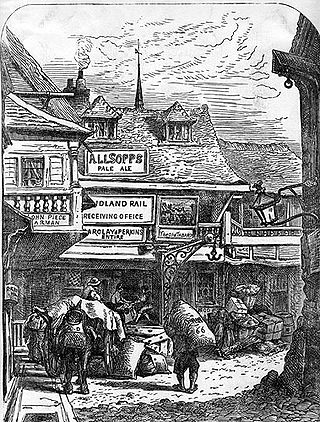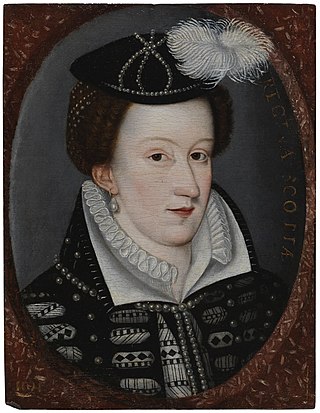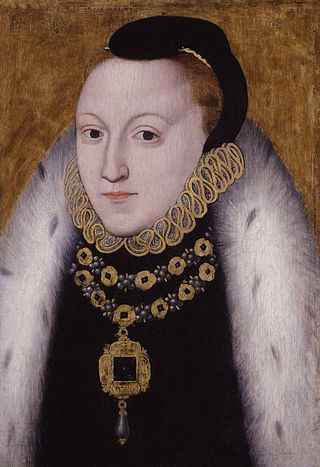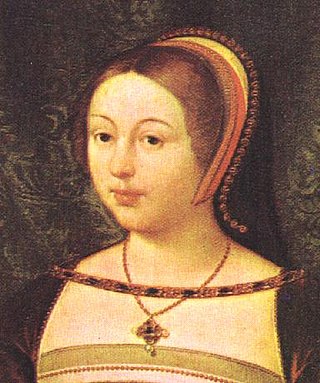Related Research Articles

The Tabard was an inn in Southwark established in 1307 that stood on the east side of Borough High Street, at the road's intersection with the ancient thoroughfare to Canterbury and Dover. It was built for the Abbot of Hyde, who purchased the land to construct a place for himself and his ecclesiastical brethren to stay when on business in London.

A pomander, from French pomme d'ambre, i.e., apple of amber, is a ball made for perfumes, such as ambergris, musk, or civet. The pomander was worn or carried in a case as a protection against infection in times of pestilence or merely as a useful article to modify bad smells. The globular cases which contained the pomanders were hung from a neck-chain or belt or attached to the girdle, and were usually perforated in a variety of openwork techniques and made of gold or silver. Sometimes they contained several partitions, in each of which was placed a different perfume.
Capt. John Martin (c.1560—1632) was a Councilman of the Jamestown Colony in 1607. He was the proprietor of Martin's Brandon Plantation on the south bank of the James River. Located in modern-day Prince George County, Virginia and known as Lower Brandon Plantation, in the 21st century, his c. 1616 plantation is both a National Historic Landmark and one of America's oldest continuous farming operations.
Robert Allot was a London bookseller and publisher of the early Caroline era; his shop was at the sign of the black bear in St. Paul's Churchyard. Though he was in business for a relatively short time – the decade from 1625 to 1635 – Allot had significant connections with the dramatic canons of the two greatest figures of English Renaissance theatre, William Shakespeare and Ben Jonson.
Robert Amadas was a London Goldsmith whose clients included King Henry VIII and his courtiers. He was Master of the King's Jewel House, and one of the Deputy Masters of the Mint.

Peter Browne, was a passenger on the historic 1620 voyage of the Mayflower and was a signatory of the Mayflower Compact.
Robert Brandon was an English goldsmith and jeweller to Queen Elizabeth I of England. A prominent member of the Goldsmiths' Company, Brandon was elected Chamberlain or treasurer of the City of London in 1583, a position he held until his death in 1591.
Perfumed gloves, also referred to as sweet gloves, are perfumed gloves, often embroidered, introduced to England from Spain and Venice. They were popular as gifts in the 16th and 17th-centuries. Stories describe them as a conveyance of poison for Jeanne d'Albret and Gabrielle d'Estrees.
Costume and gold and silver plate belonging to Elizabeth I were recorded in several inventories, and other documents including rolls of New Year's Day gifts. Arthur Jefferies Collins published the Jewels and Plate of Queen Elizabeth I: The Inventory of 1574 from manuscripts in 1955. The published inventory describes jewels and silver-plate belonging to Elizabeth with detailed references to other source material. Two inventories of Elizabeth's costume and some of her jewellery were published by Janet Arnold in Queen Elizabeth's Wardrobe Unlocke'd.
Sir Francis Gosling (1719–1768) was a partner in Goslings Bank, later Goslings and Sharpe, one of the banks merged into Barclays Bank in 1896. He was an Alderman of the City of London.

The jewels of Mary, Queen of Scots (1542–1587), are mainly known through the evidence of inventories held by the National Records of Scotland. She was bought jewels during her childhood in France, adding to those she inherited. She gave gifts of jewels to her friends and to reward diplomats. When she abdicated and went to England many of the jewels she left behind in Scotland were sold or pledged for loans, first by her enemies and later by her allies. Mary continued to buy new jewels, some from France, and use them to reward her supporters. In Scotland her remaining jewels were worn by her son James VI and his favourites.
Michael Gilbert was an Edinburgh goldsmith and financier.

The jewels of Anne of Denmark (1574–1619), wife of James VI and I and queen consort of Scotland and England, are known from accounts and inventories, and their depiction in portraits by artists including Paul van Somer. A few pieces survive. Some modern historians prefer the name "Anna" to "Anne", following the spelling of numerous examples of her signature.
Gilbert Curle or Curll was a Scottish secretary who served Mary, Queen of Scots during her captivity in England. He married Barbara Mowbray, one of three sisters serving Mary.

An inventory of the jewels of Mary I of England, known as Princess Mary or the Lady Mary in the years 1542 to 1546, was kept by her lady in waiting Mary Finch. The manuscript is now held by the British Library. It was published by Frederic Madden in 1831. Some pieces are listed twice. Two surviving drawings feature a ribbon with the inscription, "MI LADI PRINSIS". The British Library also has an inventory of the jewels she inherited on coming to the throne in 1553.

Cornelis Hayes or Heys was a Flemish jeweller who settled in London in 1524.

Affabel Partridge was a London goldsmith who served Elizabeth I. He is thought to have marked his work with a hallmark of a bird.

Several documents list the jewels of Margaret Tudor, daughter of Henry VII of England and Elizabeth of York. Margaret married James IV of Scotland in 1503.

Robert Mangot was a French goldsmith who supplied the royal court and Mary, Queen of Scots. He was a son of the goldsmith Pierre Mangot who worked for Francis I of France.
William Ward was an English goldsmith and financier from London, involved in the manufacture of glass.
References
- ↑ Visitation of London in 1568 (London, 1869), p. 39.
- ↑ Edward Arber, A Transcript of the Registers of the Company of Stationers of London, 2 (London, 1875), p. 119.
- ↑ Frederic Madden, Privy Purse Expenses of Princess Mary (London, 1831), pp. 102, 234.
- ↑ William Rendle & Philip Norman, Inns of Old Southwark (London, 1888), pp. 405-411.
- ↑ Robin Myers & Michael Harris, The Stationers' Company and the Book Trade (Winchester, 1997), p. 74.
- ↑ Thomas Rymer, Foedera, vol. 15 (London, 1713), pp. 756–59
- ↑ Calendar of Patent Rolls, Elizabeth I, 7 (London: HMSO, 1982), p. 6.
- ↑ Holly Dugan, The Ephemeral History of Perfume: Scent and Sense in Early Modern England (Baltimore, 2011), p. 111.
- ↑ Kim Hall, Things of Darkness: Economies of Race and Gender in Early Modern England (Cornell UP, 1996), p. 215.
- ↑ Nandini Das, João Vicente Melo, Haig Z. Smith, Lauren Working, 'Blackamoor/Moor', Keywords of Identity, Race, and Human Mobility in Early Modern England (Amsterdam, 2021), pp. 40-50